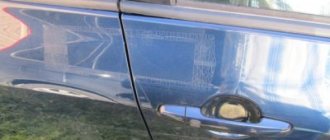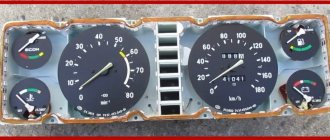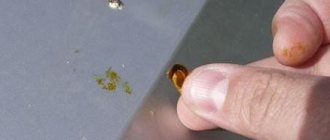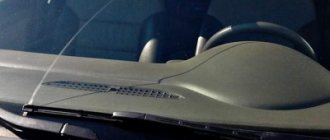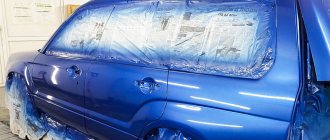Holidays in a pine forest have little to compare with. Fresh air, intoxicating aroma, solitude with nature... All these joyful feelings disappear at the sight of tar on the body of a car. It is not easy to remove such contaminants; moreover, careless actions can scratch the paintwork. We have selected the most effective, simple and safe methods that will make it easy to deal with complex stains and preserve the surface of the car.
What can I use to clean it off the body?
Tree resin is very sticky. Upon contact with air, it hardens and firmly attaches to the surface on which it comes in contact.
The resin of linden, poplar, pine and other trees has these properties. Therefore, any trip to nature can end in trouble for the motorist in the form of frozen tar stains.
If you find them, you don’t have to immediately go to the car wash ; you can try to deal with the problem on your own: using improvised means or ready-made store-bought formulations.
Folk remedies
You can get rid of tar stains using folk remedies that can be found in every home. Effective compositions:
White Spirit .
This is a popular, inexpensive solvent that can easily remove tar stains. However, it must be used carefully so as not to damage the paint. The product is applied to a soft cloth, applied to the dirt and rubbed gently so as not to leave streaks.- Hand sanitizers .
Such products are almost always on hand, so they can be used immediately after detecting a stain. The antiseptic is applied to a cotton pad, which is applied to the resin, left for 10 minutes, after which the softened composition is removed with a clean cloth. - Alcohol or vodka . Even the most inexpensive drink works great on tar stains.
Do not apply the selected product directly to the car body. First, a rag is moistened with it, which is applied as a compress to the stain for several minutes. After this, the dirt is gently rubbed, without much pressure.
If the stain is fresh, you can get rid of it using ordinary soapy water . The only condition is that it must be hot.
It is advisable to choose a microfiber cloth. It needs to be rinsed all the time so that the resin does not turn into a sticky mess and spread over the body. It will be possible to completely deal with a fresh stain in several approaches.
How to remove tar from a car, video recipe:
Special formulations
There are many compounds on sale that are designed to remove tree sap from the body. Top 3 effective remedies:
SHIMA Detailer Green Cleaner
The composition is based on an aliphatic solvent . The manufacturer claims that the product is effective not only against resins, but also against poplar buds, bitumen and tar.
SHIMA body cleaner for bitumen stains and tar Detailer Green Cleaner is applied to the surface of the body using a foam sponge, left for 2-5 minutes, and washed off with soapy water.
The price of a 0.5 liter bottle is 250 rubles.
SONAX
This is a highly specialized product designed to combat stains from tree resin. It can be used on paintwork, glass, chrome and plastic.
The mild formula of SONAX wood resin body cleaner gently removes dirt without harming the car body.
The price of an aerosol with a volume of 0.4 l is 750 rubles.
Arexons Resin and Bug remover
Arexons body cleaner spray against traces of insects and resin Resin and Bug remover acts quickly, does not harm the paintwork , and is economically consumed. To remove dirt, spray it on the stained areas, leave for a few minutes and wipe with a sponge.
The price of a 0.5 liter spray is 390 rubles.
Household chemicals
Chemistry in everyday life will allow you to clean any type of resin.
- stain removers;
- powders;
- cleaning liquids;
- acetone and other solvents.
Stain remover
It is better to take a liquid stain remover for colored laundry. You can use Vanish. Apply the product with a spoon to the contaminated area, leave for 2-3 minutes, and rinse off. The hardened resin should be lightly rubbed with a washcloth before removal.
Powder
Suitable powder for washing white laundry. The product is applied to the resin and rubbed into it until pellets begin to form.
This indicates softening and removal of resin. After completing the procedure, your hands should be thoroughly washed with soap and lubricated with a moisturizing, nourishing cream.
Detergent
Dishwashing liquid diluted with citric acid works real miracles. Acid is applied to the problem area, and a small amount of detergent is applied on top.
After 2 minutes, the resulting slurry is washed off with a washcloth.
Acetone
Acetone is a solvent and you need to be careful with it.
To wash off the resin, apply a little product to the skin and try to remove the resin. You can do this with a soft washcloth.
How to clean bitumen from the road?
Bitumen on a car is a common thing for car owners. It is enough to drive along a section of road that is being repaired or is hot, and dark stains from tar will cover the body. They can be removed either with improvised means or with specialized compounds.
Liquids at hand
Folk remedies for getting rid of road tar:
- Petrol. Every motorist always has it with him.
You can use it at any convenient time. Gasoline does an excellent job of removing both fresh and old stains, but in the latter case you will have to put in more effort. It is easy to use; just apply gasoline to a rag and wipe the dirty surface. You need to act carefully, without making much effort, since the paintwork may come off along with the bitumen. Diesel fuel and kerosene have a similar effect. - Nail polish remover . It is based on acetone, so it easily copes with tar stains. The only condition is the refusal of intense friction.
- Sunflower oil . It can be used to get rid of fresh stains before they have time to harden. Apply the oil to a rag and rub it until the body is completely clean. It will take a little effort and time, but the result will satisfy the car owner, since the oil not only removes road tar, but also does not harm the paintwork.
The video will show you how to clean your car from bitumen stains:
Cleaners
If you don’t want to use improvised means, or they turn out to be ineffective, you can purchase special substances in the store that were developed for this purpose. Popular road tar cleaners:
GraSS Antibitum
The product is effective against all types of resins, bitumen and stains from poplar buds. It acts quickly, within 1-10 minutes .
GraSS body cleaner for removing bitumen stains Antibitum is applied to the contaminated surface, left to soften the resin, rubbed and washed off with water with the addition of a degreaser.
The price of a 0.5 liter bottle is 210 rubles.
Autoland
The composition is designed specifically for the care of painted car parts . It is effective against resins, insect marks, poplar buds and bitumen stains.
Autoland body cleaner for bitumen stains and insect traces is applied to the stain for 1-3 minutes, after which it is removed with a foam sponge. If necessary, repeat the procedure.
The price for a 0.5 liter package is 180 rubles.
RunWay
Before use, shake the bottle and then distribute the composition evenly over the surface . After 30 seconds, you need to quickly remove dirt, without pressing. The main active ingredient in RunWay body cleaner for bitumen stains is aviation kerosene.
The price of a 0.5 liter bottle is 250 rubles.
Note: test review of automotive resin cleaners
Just as in the case of gasoline additives for cleaning injector nozzles, quite a few auto chemical manufacturers have rolled out their anti-bitumen products to the market. There are representatives of both well-known foreign companies and domestic teams.
The magazine "Behind the Wheel" tested products from various manufacturers. The essence of the test procedure was to evaluate the effect after using the drug in full accordance with the instructions. Resin cleaners from the following companies took part in the “race”:
- Liqui Moly (Germany – 475 rubles/400 ml).
- Kangaroo (Korea – 330 rubles/400 ml).
- Grass (Russia – 255 rubles/500 ml).
- Doctor Wax (USA – 690 rubles/475 ml).
- Autoprofi (Russia – 170 rubles/500 ml).
- Astrohim (Russian Federation – 150 rubles/500 ml).
- Sonax (Germany – 460 rubles/300 ml).
- Pingo (Germany – 520 rubles/400 ml).
- Texon (Russia – 140 rubles/520 ml).
Conventionally, products are divided into two groups: fast-acting (Astrochem, Liqui Moly, Kangaru, Avtoprofi, Sonax, Pingo), requiring long exposure (Grass, Tekson). Theoretically, the following is expected: the former do not drain, concentrating the entire volume on the affected area, the latter dissolve stains more effectively, but require more consumption. Practice confirms this.
When choosing, it is important to consider the smell. The procedure for interacting with the drug is often slow, so the aroma should not be strong. Everything is aimed at not causing discomfort to the operator, especially in the heat. The mixture from Astrohim most accurately satisfies these conditions.
How to remove it from different surfaces of the car?
If resin gets on open parts of the car, for example, on the body or roof, on the trunk or on the glass, it is not difficult to get rid of it.
Algorithm of actions:
- the car must be rinsed with clean water to remove dust and road dirt;
- soak a soft cloth in hot water and go over the stains;
- those resin traces that are not washed off with soapy water are treated with improvised means or specialized compounds.
Resin on fender flaps, arches and sills spoils their appearance, so you can’t ignore it. To clean these parts, you will need to remove them. Once they are detached, they are soaked in a hot soapy solution for 10-15 minutes.
Those stains that could not be washed off with water are rubbed with detergent solutions. You can use both improvised means and specialized chemicals.
Dry the stain with a paper towel or large napkin
Once you apply hand sanitizer to the tar stain or stuck tree buds, the stain will begin to disappear (tar) or begin to move away from the body (tree buds). Your task is to dry the treated surface with a paper towel or paper napkin.
Please note that the stain may not completely disappear and there may still be some resin residue left on the car body.
What should you not do?
To avoid damaging the car body, you should not make the following mistakes:
Do not use solvent 646, pure acetone or solvent to remove stains. These compounds are too aggressive, so together with the resin they will dissolve the paint that covers the car.- You cannot start cleaning if the machine is dirty. First you need to wash it. This will make the stains more visible.
- Do not use abrasive compounds such as baking soda or stovetop cleaning powder to remove resin.
- Do not use hard kitchen sponges, brushes or sandpaper for cleaning.
Removing stains and odors after cleaning
Fabrics quickly absorb foreign odors, and solvents, turpentine and ammonia, which are proposed to be used to clean clothes, do not have an exquisite aroma. Therefore, the question arises of how to rid the product of an unpleasant odor after removing stains.
There are several ways to do this:
- Mustard powder is brewed with boiling water and stirred until a thick mass is obtained. When the mixture has cooled slightly, apply it to the problem area of the clothing, after which the product is washed. You can simply dissolve a little powder in a bowl of water and soak the item for several hours, then wash it.
- Dissolve half a bottle of hydrogen peroxide in 10 liters of water and soak the product for half an hour. This method is only suitable for white fabrics!
- To remove extraneous odors, you can soak clothes in a soda ash solution for half an hour, and then wash them in a machine, turning on the extra rinse mode.
- A special odor eliminator, such as DoctorWax or Antismel, can be purchased at a car dealership.
- When rinsing, use double the amount of conditioner.
Helpful information
Tips to help you cope with the task more effectively:
- Before using detergent on a visible area of the car, you need to test it in an inconspicuous place. If the paintwork does not change color or wash out, you can begin to remove the resin.
- If you don't have a cleaner or solvent on hand, you can wipe off tar stains with WD-40. Almost every motorist has a can of this product. The composition is especially effective in combating fresh stains.
- Most resin removers are based on petroleum fractions, so they are flammable and also have a specific odor. Therefore, you need to work with them carefully.
- If the stain is large, then remove it point by point. Apply the product using a brush. This is a rather tedious task, but this way you will be able to avoid subsequent painting of the car.
- After treatment, the car must be washed using car shampoo.
Recipes and tips for removing resin from various surfaces are presented in this section.
Reasons for the appearance of bitumen stains on a car
Bitumen stains appear on the car body, falling onto it from the asphalt surface. The main reasons for this phenomenon lie in the following:
- premature use of a newly repaired road section, when the new road surface has not yet fully formed;
- During hot periods, asphalt tends to melt under the influence of high temperatures. Resin, which is actively used in road repairs and filling potholes, is subject to the same process. Combined with the fact that in hot weather the temperature of the car body can reach 80 ° C, bitumen, when it comes into contact with a heated paint coating, is very easily introduced into its structure;
- The reason for the appearance of such pollution is also the fact that particles of tar fall onto the car body from the wheels of nearby passing cars. It should be taken into account that the higher the speed on the new road, the further such particles will fly off.
Advice! In order to wipe the bitumen off the car, you need to start this process as soon as possible after the contamination has been discovered. Fresh stains (when the tar has not yet been completely absorbed into the paintwork) are much easier to remove than hardened stains.
Most often, the following elements of the car body suffer from this type of contamination:
- bumper;
- wheel arches;
- bottom of doors;
- thresholds.
There are certain preventive measures that will minimize the risk of bitumen contamination on the car body:
- compliance with the speed limit for driving along the recently repaired section of the road (ideally, the speed should not exceed 50 km/h);
- maintaining a distance between cars when driving (this is especially true for trucks, when driving next to them, bitumen can even get on the windshield of the car);
- timely installation of special mudguards;
- applying a protective coating to the car body.
What should you do to protect your car from tree sap?
- As we have already written, do not park under flowering trees or park your car in a closed parking lot, say, during the flowering of poplars.
- If you do find yourself parking under trees when they are in bloom, consider getting a protective cover. It will prevent drops of resin from getting on the body.
- The resin will be less likely to eat into the paintwork and damage it if it is treated with a protective polish or hard wax. The special film created by these means will prevent the penetration of organic matter into the structure of the paintwork and its destructive effects. If resin gets on the body, it will be much easier to remove.
Factory auto chemical goods
Many car stores offer various automotive chemicals for removing stains from the body. Whatever the manufacturer, the principles of use differ little from each other. In any case, you must carefully read the instructions before use.
- First, you should wash the car using a soap solution. It is advisable to use hot water. This will soften the hardened resin marks a little.
- Then wet a rag and place it on the stain.
- After a few minutes, we begin to scrub the surface using circular movements. You shouldn’t use too much force, otherwise you can grind the resin over a large area.
- Finally, if necessary, restore the wax coating of the body.
Chemical composition and applications of resins
- Resin is a substance produced in some plants, especially conifers. It occurs in the intercellular spaces or resin ducts, and is produced by the surrounding secretory (resin-bearing) cells. Resin is used to protect the trunk and tree wounds. The color depends on the type of wood from which it was obtained.
- Resins are insoluble in water and are amorphous or partially crystalline mixtures of non-volatile organic compounds, terpenoids (resin acids and their derivatives) and phenolic compounds.
- Resin is extracted from living trees by resin selection (the process of obtaining a substance from trees by cutting off the bark and collecting the flowing liquid in special containers), from felled trees, branches, and pine needles. Resins have very different uses, depending on the specific type. Some are used in pharmacology in the form of drugs or ingredients for their production. The rest are used to produce natural rosin, shellac and turpentine. They are used to produce paints and varnishes.
- Resin is a raw material used in the production of cosmetics, plastics, undersea electrical cable insulation and many other products. In Siberia, the resin of these species of Siberian and Daurian larch is extracted for chewing and, according to methods, disinfects the oral cavity. Fossil resin (amber), widely used in jewelry.

